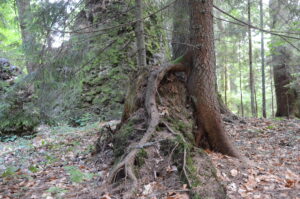-
Partager cette page
Are the remnants of old-growth mountain forests always relevant to inspire close-to-nature forest management and efficient biodiversity conservation?
Ce travail a été piloté par Laurent Larrieu (Dynafor, CRNF-CRPF) et Antoine Brin (INPT Purpan, Dynafor). Il repose sur l’important travail d’inventaire des vieilles forêts réalisés par le groupe d’étude des vieilles forêts pyrénéennes auquel a participé Nicolas Gouix. En lien avec le projet BENDYS, Sylvain Burri et Vanessa Py-saragaglia ont été associés à cette étude qui vise à (1) identifier les facteurs qui expliquent la localisation actuelle des forêts anciennes et matures, à (2) évaluer leur potentiel en tant qu’écosystèmes de référence et à (3) discuter de la pertinence du réseau actuel pour la conservation de la biodiversité. Les résultats montrent qu’au-delà des aspects biogéographiques et topographiques, le type de propriété est la caractéristique la plus influente et qu’une large part de la variance dans la localisation de ces forêts est à chercher dans les trajectoires historiques micro-régionales. L’intégration de la longue durée des interactions sociétés-environnement se confirme être indispensable pour mieux comprendre la distribution spatiale de ces écosystèmes de référence pour la conservation de la biodiversité.

Can these AMF remnants provide suitable benchmarks and insure biodiversity conservation? This study aimed to (i) identify factors that explain the current location of AMFs; (ii) assess the potential of these AMFs as reference ecosystems; and (iii) discuss the relevance of the current AMF network for biodiversity conservation. We used a set of 10,344 1 ha-plots, described by 10 metrics for both abiotic conditions and the socio-economic context, to compare AMFs with both forests that are ancient but not mature, and recent forests.
AMFs significantly differed from other forests for most of the variables tested, but effect sizes were rather weak, with the exceptions of the occurrence of late frost, exposition and ownership type.
Our study provides important insights for biodiversity conservation beyond the case of the northern slope of the Pyrenees. Indeed, our results clearly show that broad-scale patterns require complementary investigations at a regional scale to better understand the influence of past-human activity on the spatial distribution of reference ecosystems. We also illustrate the added value of including geological features and plant communities in the analysis of ecological representativeness of networks dedicated to biodiversity conservation.
Lire la suite sur le site de sciencedirect






